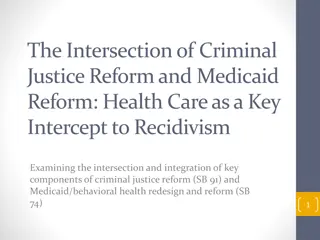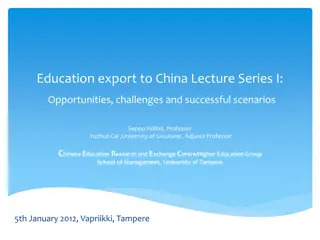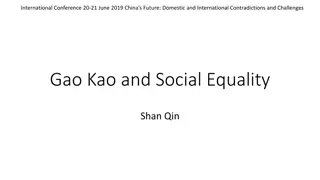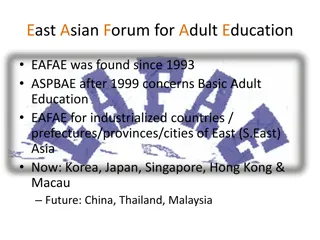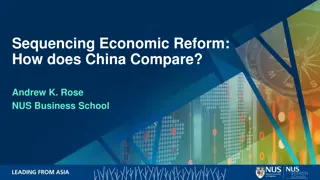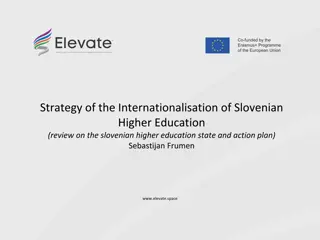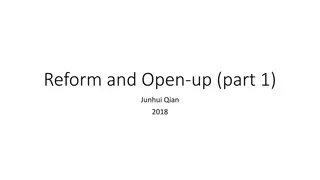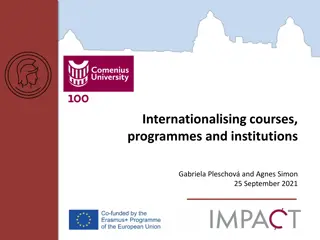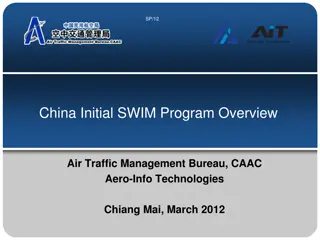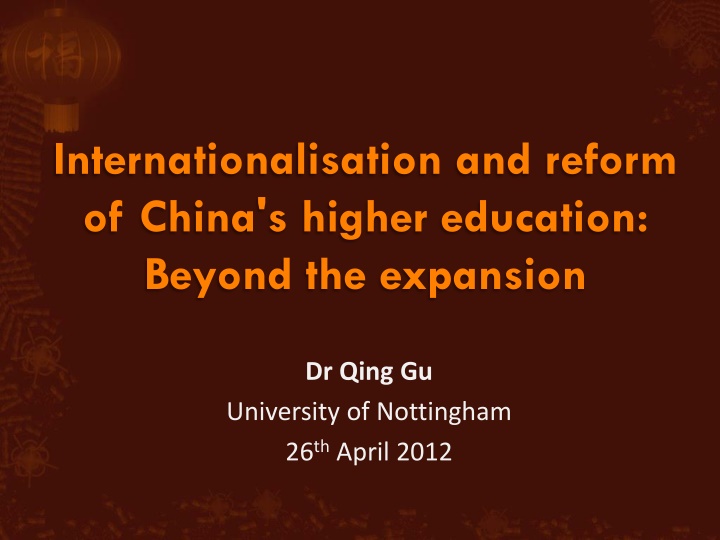
China's Higher Education Transformation: Internationalisation, Expansion, and Quality Goals
Explore the evolution of China's higher education system, focusing on internationalisation, expansion, and quality enhancement initiatives. Discover key statistics, government projects, and strategies outlined to elevate Chinese universities to global prominence.
Download Presentation

Please find below an Image/Link to download the presentation.
The content on the website is provided AS IS for your information and personal use only. It may not be sold, licensed, or shared on other websites without obtaining consent from the author. If you encounter any issues during the download, it is possible that the publisher has removed the file from their server.
You are allowed to download the files provided on this website for personal or commercial use, subject to the condition that they are used lawfully. All files are the property of their respective owners.
The content on the website is provided AS IS for your information and personal use only. It may not be sold, licensed, or shared on other websites without obtaining consent from the author.
E N D
Presentation Transcript
Internationalisation and reform of China's higher education: Beyond the expansion Dr Qing Gu University of Nottingham 26thApril 2012
Some Statistics (1) The worldwide participation rate has risen from 28.6m in 1970 to 152.5m in 2007, an average annual increase of 4.6%. Rapid growth is reported in East Asia and the Pacific where the number of students has risen from 3.9m in 1970 to 46.7m in 2007. This is primarily due to China, where the number of students in higher education has grown on average by almost 19% each year since 2000 a veritable explosion. (UNESCO: Global Education Digest 2009)
Some Statistics (2) Graduation ratios (i.e. the number of graduates : the population of graduation age): the largest absolute number of tertiary graduates in 2003, the ratio is 11.7% (cf 60.7% in Australia; 53.5% in New Zealand; 40.1% in Japan; 20% in HK; ). (UNESCO 2009)
Quantity: Great Outcomes There are 2,700 higher education institutions in China. The total enrolment of HEIs has reached 30 million, with a gross enrolment ratio of 26.9%. The scale of our higher education system is no doubt the largest in the world and we are proud of this great achievement. (MoE national conference on improving the quality of higher education in China, Beijing 27thMarch 2012)
Quality: Long-term Goals Making Chinese higher education internationally competitive: Improving the quality of higher education is now the most urgent and most important task. A number of research and innovation centres will be established across the country in order to: Bring scientists and scholars together for internationally recognised cutting edge research Promote inter-institutional cooperation Nurture outstanding talent Create research and development bases for high-tech innovation in order to promote knowledge transfer and utilisation Cultivate a number of top-ranked world-class universities (MoE, 27thMarch 2012)
211 Project and 985 Project These projects were initiated the end of 1990s to develop high-level research and world class universities. The aim of the 211 project is to build up 100 top level HEIs and key disciplines in the 21st century. The 985 project aimed at developing 10 to 12 so-called world- class, plus a number of renowned high-level research institutions. Investments from the government in these key universities are much higher than in other higher education institutions.
The Driving Force Economic development: Rapid economic growth has provided both the resources to support the expansion and the jobs to absorb graduates (Hayhoe, 1999) the need to produce an increasingly knowledgeable workforce equipped to handle the challenges of an economy that is not only growing extremely rapidly, but also becoming increasingly diversified and sophisticated. (Wang, 2010)
Two Major Focuses of Reform Decentralisation: Give universities autonomy Release central control from the government whose function is to be limited to providing services and funding Modification of the college admission process Change from one-exam-decides-all method to multiple tests which ensure a thorough evaluation of a student as a whole person (Development Plan 2010-2020)
History of Higher Education First modern Chinese university was established in 1895 1895: Beiyang gongxue (forerunner of Tianjin University) 1896: Nanyang gongxue (later Jiaotong University) 1898: Imperial University (Peking University) (Hayhoe 1999)
Two Cultural Legacies (1) Western idea of the university introduced by governmental officials of the Qing dynasty in order to empower the government by building up modern universities to educate and nurture talent with modern technologies, in addition to classics Chinese scholars who received their higher education at Western universities
Two Cultural Legacies (2) Chinese tradition of education influenced by the Confucian value of training scholars to be government officials the classical principle of Chinese learning as the essence, Western learning for its usefulness (Pan 2009)
Entry into Higher Education: History The Imperial system (Confucian classical doctrine): After the sixth century, China set up an Imperial Examination system to screen governmental officials which lasted over 1,300 years (abolished in early 20th century). Successful candidates would be assigned to different types of jobs in administration, legislation or even military affairs. An arm of the state for recruiting and training civil officials A screening device to select lites although it had other political, cultural and academic functions
Values? Neither autonomy nor academic freedom
Cultural Dialectic Opposing scholarly values and tensions: Absolute intellectual authority of the inner circle of scholar-officials VERSUS Intermittent intellectual freedom which at times offered a direct challenge to imperial authority (Hayhoe 1999)
2010: Greater Autonomy Evaluating schools without much research capacity, whose strengths might lie elsewhere, by the number of papers produced could lead to rushed and exaggerated results. Different universities should be cultivating their individual strengths. (Rao Yi, Dean of School of Life Sciences, Peking University & Shi Yigong, Dean of School of Life Sciences, Tsinghua University)
Entry into Higher Education: Present The higher education system in China still adopts the elitist screening approach to recruit prospective entrants. However, given its continuous expansion, the Chinese higher education system is moving from an lites to mass higher education. Employers pay more attention to graduates educational status and provenance rather than to credits, class rank or the status of job matching.
Enrollment Increases: Some Statistics Enrollment in 1980s and early 1990s: 3-4%; Enrollment reached 7.2% in 1995, 12.5% in 2000, 15% in 2002, and around 17% in 2003, with 20 million students enrolled; By 2005, 23 million students are studying in universities, comprising 21% of the cohort. (MoE 2007)
Mass Higher Education The construction of university cities or university towns ; After mergers and expansion of enrollment, some universities have over 70,000 students with multiple campuses.
Theories Driving the Expansion Human Capital Theory: Education can enhance human capital, increase the individual s productivity, and contribute to economic development. Population burden vs huge human resources powerhouse knowledge economy and knowledge society: China s economic advantage and disadvantage in international competition; Higher education redefined as consumption (comments of MOE officials)
Social and Demographic Changes The cultural tradition; Demographic changes: single-child family; Parents willingness to invest; The rise of a new middle class; Urbanization.
However, In China, only one-half of the upper secondary education graduates who are qualified to pursue their education do so. The current intake of tertiary education is not limited by the output of upper secondary education but by other factors, such as: tuition and living costs, university entrance exams or simply by the fact that other options outside tertiary education are equally or more profitable. (UNESCO 2009)
Private Higher Education Three types: Institutions established by private actors (e.g. entrepreneurs, private enterprises) and can grant associate or bachelor degrees (min ban higher education) Before 1980: zero By 1999: 43 By 2008: 318 (1,828,633 students) Independent colleges which offer bachelor degree programmes (Duli Xueyuan) Institutions which cannot grant any degrees or diplomas but facilitate students to study to pass national self-study examinations. 1) 2) 3) (Ministry of Education, 2009)
Private Higher Education: Features Registered in the business sector: student fees account for 80% of the total income Regulated by the market mechanisms (rather than by the state), but easily influenced by (inconsistent) state/regional policy and social factors Non-elite/demand absorbing: developed to supplement the shortage of education supply by the public sector Technical or professional colleges with a clear intention to provide an entry to the labour markets for their students (Li & Morgan 2008)
Private HE: Features Social equity issue: Access to private higher education with high quality Competitiveness in the job market Location consistent with economic distribution (e.g. major cities in eastern China) More capital investment available A stronger will to improve private higher education from local governments More public education resources to draw upon More potential students (Li & Morgan 2008)
Expansion of HE and the Labour Market The rates of return (ROR) to higher education may not decline but even continue to rise in the near future (Li et al., 2008): Since the early 1990s, although there has been a sustained growth of the higher education system, the ROR to higher education has also undergone a sustained increase, from 4% in 1991 to 19% in 2004 (Chen et al., 2003; PKU GSE, 2005). The current ROR to higher education in China has exceeded the international average, and it can be said that Chinese higher education has entered a stage of high marginal returns (Chen et al., 2003).
Challenges Cultural collision: creativity, independent thinking and academic autonomy versus cultural values which cherish obedience as a virtue resolved with time and collective efforts Ethical issues, particularly related to college admission process: worries about bribery and corruption reinforce the law Social justice: access to higher education and career opportunities (individual, institutional and regional) enhance the diversity of higher education provision
International Student Mobility: Statistics and Emerging Trends In 2007, over 2.8m students were enrolled in educational institutions outside of their country of origin, an increase of 4.6% on the previous year. Two emerging trends: International students are more likely to stay within their regions of origin. Growing choice of study destinations: Greater choice has meant greater dispersion of students and a dilution of market shares. i. ii. (UNESCO 2009)
Study Destinations Widening options 38% of mobile students from China pursued their studies in the United States in 1999. This share fell to 23% in 2007 even though the absolute number of these students rose steadily over the period. Australia, Germany, New Zealand, the Republic of Korea and the United Kingdom gained the most from this shift, attracting about 162,000 more Chinese students since 1999.
University Student Mobility In 2007, 29% of global mobile students were from East Asia and the Pacific. Students from China accounted for one seventh of the total (15%). China sends the greatest number of students abroad, amounting to almost 421,100. The other major countries of origin are: India (153,300), the Republic of Korea (105,300) (UNESCO 2009)
Outward Tertiary Students Mobility Despite these high absolute numbers, only less than 2% of tertiary students from China study abroad. Local tertiary enrolment grew at a faster pace than the number of mobile students: tertiary enrolment grew by 18.9%, compared to a 15.3% rise in student mobility. (UNESCO 2009)
Brain Drain? By 2006, 1.07 million Chinese students have studied overseas since China s reform and opening up in 1978, but only a quarter (275,000) have returned to work in China. However, Of the 792,000 who remained abroad since 1978, an estimated 300,000, slightly over a third (38%), work overseas. This begs the question of the career prospects of the majority of the Chinese who have stayed abroad. Since 2003 proportionately there have been more Chinese returning home than those who have gone abroad to study each year (average annual increase of 28% for returnees). (Chinese Academy of Social Sciences 2007)
Brain Drain? Annual Ratio (Returned Chinese : Studying Abroad) 1.00 2003 2004 2005 2006 0.10
Brain Gain? There were 180,000 registered foreign employees in China by 2006, an increase of approximately 100% since 2003, according to the Ministry of Labour and Social Security of China. Statistics from the Chinese Ministry of Education shows that the number of international students studying in China increased from 43,000 in 1998, 86,000 in 2002, 140,000 in 2005, and 223,000 in 2008.
Other Forms Attracting international students to study in China: New popular study destinations: China; Korea; New Zealand Establish joint degree courses offered by foreign universities in China Enhance research collaborations and networks with foreign institutions
THANK YOU Qing.Gu@nottingham.ac.uk




